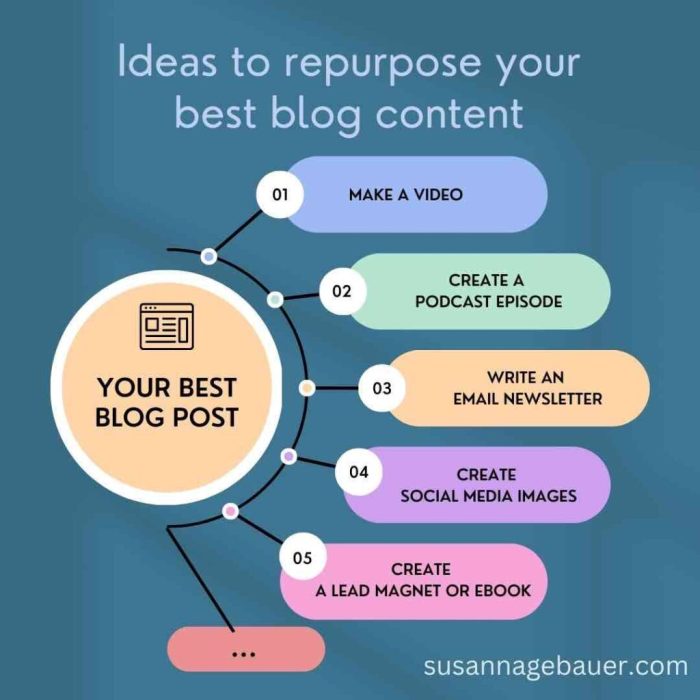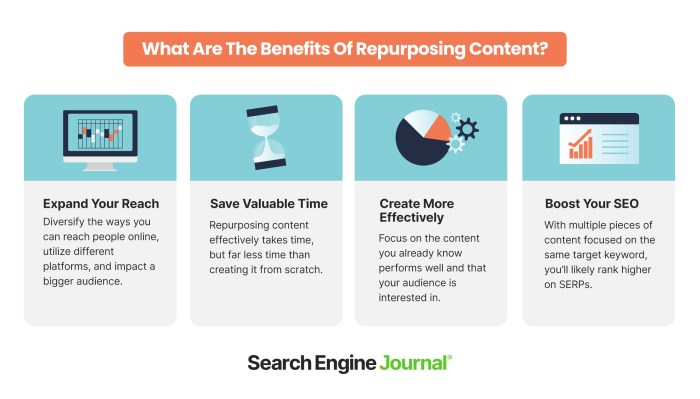Developing a Content Repurposing Plan dives into the art of repurposing content to maximize its reach and impact. From defining the concept to exploring successful strategies, this topic is all about revamping your content game.
Identifying your target audience, selecting the right platforms, and optimizing content are just a few key steps in this exciting journey. Get ready to take your content to the next level with these expert insights!
Introduction to Content Repurposing

Content repurposing is the art of taking existing content and transforming it into new formats to reach a wider audience and maximize its value. It involves recycling, reusing, and reshaping content to fit different platforms and cater to diverse preferences.Developing a content repurposing plan is crucial for businesses and individuals looking to extend the lifespan of their content, increase brand visibility, and drive engagement.
By strategically repurposing content, you can amplify your message, enhance your reach, and establish yourself as a thought leader in your industry.
Importance of Developing a Content Repurposing Plan
Repurposing content allows you to leverage the efforts put into creating original content while adapting it to suit various channels and audience segments. It helps in maximizing the return on investment (ROI) by extending the longevity of your content and increasing its impact over time. With a well-thought-out content repurposing plan, you can streamline your content creation process, improve , and boost your online presence.
- Repurposing blog posts into social media graphics, videos, or podcasts can attract new followers and drive traffic to your website.
- Turning webinar recordings into blog articles or infographics can cater to different learning preferences and engage a wider audience.
- Repurposing whitepapers or case studies into email newsletters or webinars can nurture leads and build credibility with your target audience.
By repurposing content, you can breathe new life into your existing materials and make them work harder for your brand.
Identifying Target Audience and Platforms

Identifying the target audience for repurposed content is crucial for ensuring that your message resonates with the right people. This involves understanding the demographics, interests, and behaviors of the individuals you are trying to reach.When it comes to platforms suitable for repurposing content, there are several options to consider. Some popular choices include social media platforms like Facebook, Instagram, and Twitter, as well as professional networks like LinkedIn.
Additionally, websites, blogs, and email newsletters can also serve as effective platforms for repurposed content.Tailoring content for specific platforms is important because each platform has its own unique audience and format requirements. For example, content intended for Instagram may need to be more visual and engaging, while content for LinkedIn may need to be more professional and business-oriented. By customizing your content for each platform, you can maximize its impact and reach the right audience effectively.
Importance of Tailoring Content for Specific Platforms
- Understand the audience demographics and preferences of each platform.
- Adapt the format and tone of your content to align with the platform’s style.
- Utilize platform-specific features and tools to enhance engagement.
- Optimize content for each platform’s algorithms to increase visibility.
Content Audit and Selection
When it comes to repurposing content, the first step is to conduct a thorough content audit. This involves reviewing all existing content to determine what is suitable for repurposing and what needs to be updated or discarded.
Content Audit Process
To conduct a content audit, start by creating a spreadsheet or document that lists all your existing content pieces. Include information such as the title, format, publication date, and performance metrics (such as views, shares, etc.). Analyze each piece of content to determine its relevance, accuracy, and effectiveness in reaching your target audience.
- Identify top-performing content: Look for content that has high engagement rates, such as likes, shares, and comments.
- Assess outdated content: Check for content that is no longer relevant or accurate and needs to be updated or removed.
- Consider evergreen content: Look for content that is timeless and can be repurposed without losing its value.
- Review content gaps: Identify areas where you lack content and need to create new pieces to fill those gaps.
Criteria for Selecting Content
When selecting content for repurposing, consider the following criteria:
- Relevance: Choose content that is still relevant to your target audience and aligns with your current marketing goals.
- Quality: Select content that is well-written, informative, and provides value to your audience.
- Versatility: Opt for content that can be easily transformed into different formats without losing its core message.
- Performance: Prioritize content that has performed well in terms of engagement and conversion rates.
Choosing Content Formats
When deciding on content formats for repurposing, consider the preferences of your target audience and the platforms where you plan to share the content. Some popular formats for repurposing content include:
- Infographics: Visual representations of data or information that are easy to share and understand.
- Videos: Engaging and interactive content that can be shared on social media platforms.
- Podcasts: Audio content that allows you to reach audiences on-the-go.
- Blog posts: Written content that can be updated, expanded, or condensed to suit different platforms.
Repurposing Techniques and Tools: Developing A Content Repurposing Plan
When it comes to repurposing content, there are various techniques that can help you effectively reach your target audience across different platforms. Additionally, there are tools available that can streamline the repurposing process, making it more efficient and manageable. Let’s explore some of these techniques and tools below.
Repurposing Techniques
One effective technique for repurposing content is to create different formats of the same content. For example, you can turn a blog post into a video, infographic, or podcast episode. This allows you to cater to different audience preferences and reach a wider audience.
- Repurpose long-form content into bite-sized pieces for social media posts.
- Create a series of related content pieces that can be released over time to keep your audience engaged.
- Update and refresh existing content to keep it relevant and valuable to your audience.
Repurposing Tools
There are several tools available that can help automate the repurposing process and make it more efficient. These tools can save you time and ensure consistency across your repurposed content.
- Canva: A graphic design platform that can help you create visually appealing graphics and infographics to accompany your repurposed content.
- Buffer: A social media management tool that can schedule and publish your repurposed content across multiple platforms.
- Rev.com: A transcription service that can convert your audio and video content into written format for repurposing.
Optimizing Repurposed Content
When it comes to repurposing content, optimizing it for is crucial for reaching a wider audience and improving search engine rankings. By implementing best practices in your repurposed content, you can increase visibility and attract more organic traffic to your website or platform.
Importance of Optimizing Repurposed Content for
Optimizing repurposed content for involves incorporating relevant s, meta tags, and descriptive headers to make it more searchable and discoverable by search engines. By optimizing your content, you can improve its chances of ranking higher in search results, driving more traffic to your site.
Tips for Repurposing Content Without Duplicating
- Avoid copying and pasting content directly from the original source.
- Rewrite the content in your own words to add value and uniqueness.
- Focus on updating and refreshing the information to keep it relevant to your target audience.
- Consider repurposing content in different formats, such as videos, infographics, or podcasts.
Ways to Maintain Consistency Across Repurposed Content, Developing a Content Repurposing Plan
- Establish brand guidelines to ensure a consistent tone and style across all repurposed content.
- Use the same color scheme, fonts, and visual elements to maintain brand identity.
- Create a content calendar to plan and organize repurposed content in advance.
- Regularly review and update repurposed content to reflect any changes in your brand or industry.
